The issues Tesla ran into as it ramped up production of the Model 3 were well documented. Company co-founder and CEO Elon Musk candidly called the situation “production hell” on several occasions. Tesla managed to beat the odds and mass-produce the Model 3, its entry-level offering, and it released a time-lapse video that sheds insight into how the electric sedan comes to life.
The Model 3 starts life as a prepainted metal shell with a hood, a handful of plastic clips, but little else. As it rolls down the assembly line, the first order of business is to begin installing the wiring that runs equipment like the power windows, and the sound-deadening material on the firewall. Electronic components come next, followed by a single unit that encompasses the dashboard, the giant touchscreen, and the stalks on either side of the steering wheel. Combining these parts into one represents Tesla’s approach to streamlining its production process. To add context, Digital Trends has visited car factories in which the dashboard, the stalks, and the touchscreen are installed separately.
The screen comes to life later in the production process, and the Model 3 gets carpet shortly after. Workers install the doors (which are already fitted with windows and panels) right before driving the Model 3 off of the assembly line. It’s interesting to note that the infotainment system goes into factory mode after the car is turned on for the first time.
All told, building a Model 3 requires 40 steps that are accomplished in 90 minutes, according to Business Insider. The production line stretches about 1,000 feet long.
The video gives us a rare look into the Fremont, California, factory that also produces the Model S and the Model X. The company famously built a tent right next to the Fremont factory to boost Model 3 production. The sedan’s electric motors and lithium-ion battery packs come from the Gigafactory located on the outskirts of Reno, Nevada.
Tesla’s manufacturing footprint will grow in the coming years. The California-based company will break ground near Shanghai, China, during 2019 to build Gigafactory 3. The facility will build battery packs, and it will initially have an annual production capacity of 250,000 cars. Its roster of models will include the Model 3 and the upcoming Model Y.
Editors' Recommendations
- Fly through Tesla’s Giga Berlin factory in this epic drone video
- Tesla Model Y vs. Nissan Ariya: Can Tesla take out Nissan’s electric crossover?
- Tesla Model 3 vs. Tesla Model Y: Bigger or cheaper?
- The Tesla Model Y is far from my favorite EV, but I’m pretty close to buying one
- Tesla Model 3 vs. Hyundai Ioniq 6: Which electric sedan is best?




